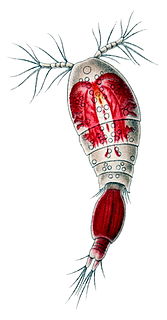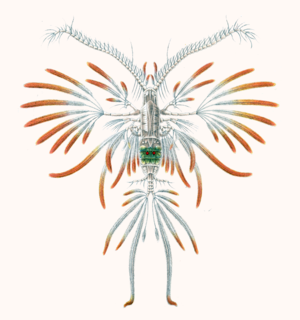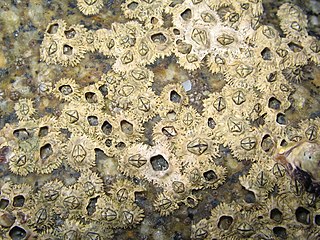
The family Argulidae contains the carp lice or fish lice – a group of parasitic crustaceans of uncertain position within the Maxillopoda. Although they are thought to be primitive forms, they have no fossil record. The Argulidae are the only family in the order Arguloida, although a second family, the Dipteropeltidae, has been proposed.

Calanus is a genus of marine copepod in the family Calanidae. The genus was split in 1974, with some species being placed in a new genus, Neocalanus. The following species are recognised:
Notodiaptomus is a genus of copepods in the family Diaptomidae. It is the most widely distributed, most abundant and most species-rich genus of freshwater calanoid copepods in the Neotropics. The genus was erected in 1936 by Friedrich Kiefer for eleven species formerly placed in a wider Diaptomus. Notodiaptomus deitersi was chosen to be the type species by Raúl Adolfo Ringuelet in 1958.

Oncaea is a genus of copepods. The genus contains bioluminescent species. Unlike other bioluminescent copepods, Oncaea have an internal (non-secreted) bioluminescence. Oncaea contains the following species:

Sapphirinidae is a family of parasitic copepods in the order Poecilostomatoida.

Sapphirina, whose members are commonly known as sea sapphires, is a genus of parasitic copepods in the family Sapphirinidae.

Acartia is a genus of marine calanoid copepods. They are epipelagic, estuarine, zooplanktonic found throughout the oceans of the world, primarily in temperate regions.

Calocalanus is a genus of copepods, the only genus in the family Calocalanidae:
Centropagidae is a family of copepods. Its members are particularly known as plankton in coastal waters and in fresh water in Australia and southern South America. They are also found on subantarctic islands and in lakes in Antarctica.
Phaennidae is a family of planktonic copepods, found in pelagic or benthopelagic waters. It contains the following genera:
Pontellidae is a copepod family in the order Calanoida, containing the following genera:
Pontella is a marine copepod genus in the family Pontellidae. It is an organism that bears three lenses in the eye. The outer has a parabolic surface, countering the effects of spherical aberration while allowing a sharp image to be formed.

Temoridae is a family of copepods, containing the following genera:

Euaugaptilus is a genus of copepods.

Lepeophtheirus is a genus of sea lice. The best-known species is L. salmonis, the salmon louse. Other species include L. pectoralis, which uses flatfish as its host, particularly the European flounder, and is also the type species of the genus Lepeophtheirus.
Centropages is a genus of copepods in the family Centropagidae with 34 known marine species.

The clade Multicrustacea constitutes the largest superclass of crustaceans, containing approximately four-fifths of all described crustacean species, including crabs, lobsters, shrimps, woodlice, prawns, krill, barnacles, crayfish, copepods, amphipods and others. The largest branch of multicrustacea is the class Malacostraca.

The Hexanauplia constitute a class of crustaceans, comprising three groups: the Copepoda, the Tantulocarida and the Thecostraca.

Temora is a genus of copepods in the family Temoridae. The World Register of Marine Species lists the following species:
Oithona is a planktonic crustacean genus found in marine, brackish, fresh water environments. Oithona has been described as the most ubiquitous and abundant copepod in the world's oceans. It was first described by Baird in 1843 using the species Oithona plumifera as taxon type.












